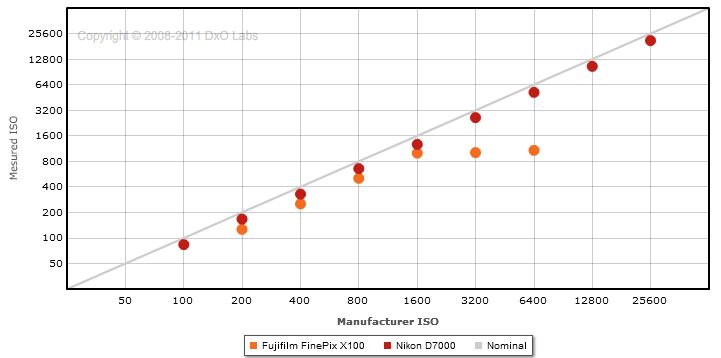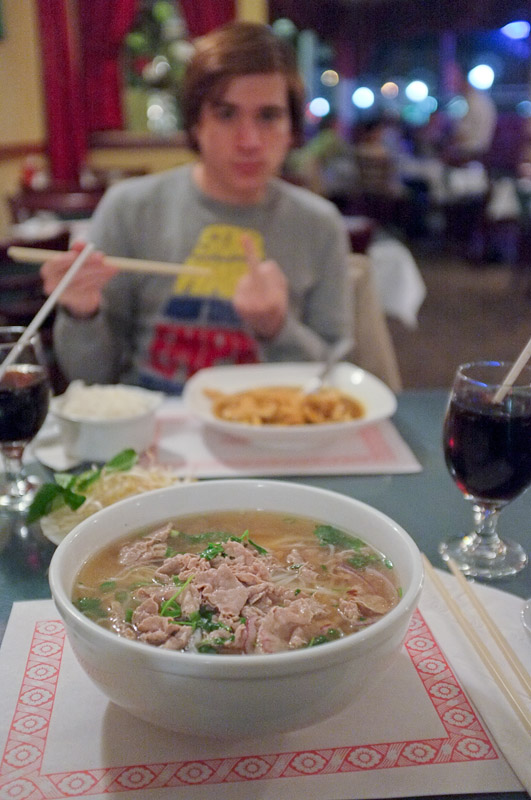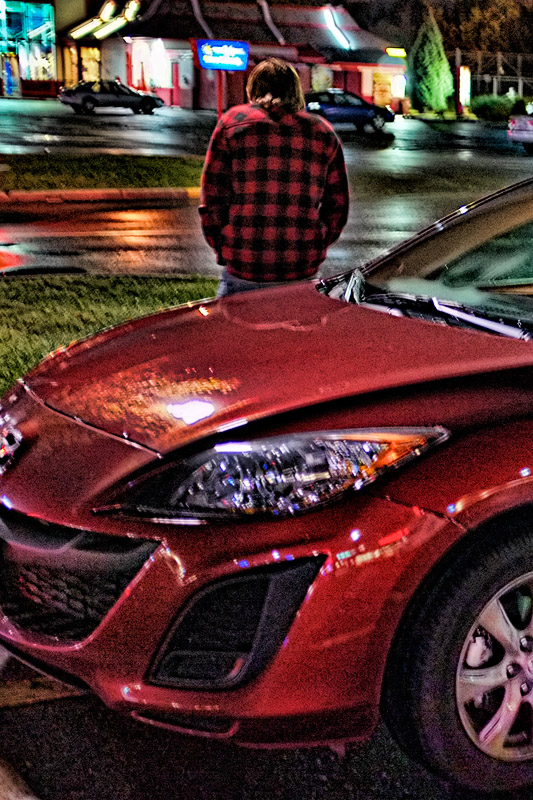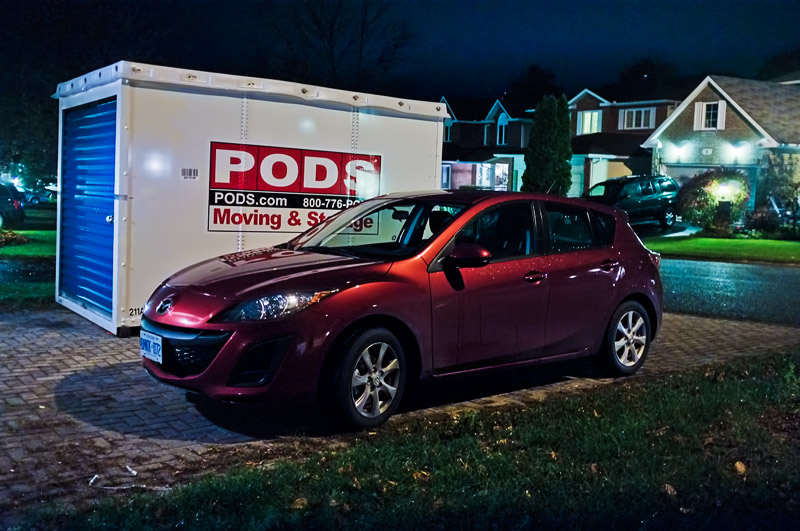Sorry for these complex titles, but I can’t really use subtitles on the blog and I don’t want to create separate pages for cameras etc.
This is again a fairly informal review as I am waiting for my Ikea kitchen cabinets to be delivered. I shot a few images this morning with the D7000 and X100. In fact, they shot each other, which I thought an amusing way to introduce them to each other. Both were shot at 3200 ISO (the Fuji in auto ISO and the Nikon explicitly chosen.) I also shot the pair of cams with the F550EXR for the first comparison round, an image you may already have seen.
Here it is again:

But what’s actually in there? After all, this is a fairly heavily processed image. So here is the image after ACR conversion but with nothing else done to it. The crops show you what is in the raw 16mp data.

There was really no reason to show you that, except to remind you that Fuji are making some pretty nice CMOS sensors these days. For a tiny 1/2” sensor at 3200 ISO, this is an excellent performance.
Now, on with the show. I first shot the D7000 with the X100. I used macro mode and again shot at f/2, using every advantage that the X100 can bring to bear. The result is a little ambiguous, to be honest.

As you can see, the 100% crop inset shows that the image’s edges are quite soft and the contrast is quite low. There is no movement showing, which means that this is not a case of camera shake softening the image, but rather it is very likely a case of this fast prime behaving like almost all fast primes – having a slightly soft and low contrast character when shot wide open.

It does clean up nicely, so I would not be too perturbed about how it looks. The grain is quite fine (click on the image to see it full sized at 800px, which bring the crop to full size as well.) And you could get away with calling it film-like.
The dynamic range is a bit weak from what I saw in ACR. The right side of the lens is quite bright, and I could not take it down with the ACR recovery slider. That would concern me were I wanting to shoot in contrasty conditions a lot …
I’ll examine the exposures of these camera a bit later, as they tell an interesting story.
Meanwhile, let’s see how the D7000 shot the X100.
I could not get as close to the X100 because I chose to shoot at about the same focal length, which of course handicapped the 18-200VR lens. It gets better magnification at 200mm, so I could have shot it there and got a much nicer image. But I did not …

Still a very nice shot with really excellent contrast and details for a simple kit lens. I did shoot it in live view mode, as I thought it would be nice to use each with contrast AF. The detail in the inset crop is clear and contrasty and has excellent 3-dimensionality. I like it a lot. The kit lens was shot wide open, in case anyone wonders. Again, the discussion of the actual exposures will come at the end.
When I crop the image to get a bit closer (I have 33% more pixels in the D7000 so some cropping does not cost me much image quality), I see a really nice image of the X100 with excellent tone and contrast and very nice acuity.

Remember … this is an 11x kit lens against a special purpose fixed prime lens. Ponder that one while we move on to exposures and a discovery that really surprised me.
First off, let me be clear that I have not followed the X100 at all since it came out. It has sold very well for Fuji and once you play with one you can easily see why. It is fun to shoot an old school interface and it does make really nice images. F/2 is terrific for subject isolation, even at 35mm EFL. So there is no mystery as to why it is a big seller.
But … there is definitely a mystery contained in these images. Why are the exposures do different?
To examine these as accurately as possible, let’s look at the exposures and try to normalize them to one reference point … the F550EXR was shot a few minutes later, but the light seemed to be the same so I will use the F550’s exposure as the prime reference.
| Camera | Compensation | Aperture | Shutter Speed | ISO | Off by |
| F550EXR | 0 | f/4 | 1/13s | 3200 | 0 |
| X100 | 0 | f/2 | 1/25s | 3200 | A:+2EV S: –1EV T: +1EV |
| D7000 | +.33 | f/3.8 | 1/40s | 3200 | A: 0EV S: –1.6EV T: –1.6EV |
How peculiar. The D7000 is clearly biased down by a couple of stops on its Matrix meter since I told it to bias up by 1/3 stops and it still chose an exposure 1 and 2/3 stops lower. But that’s ok, because the D7000 is known to have most of its extended dynamic range in the shadows, and the quality of the black areas of the body of the X100 shown above certainly do not conflict with that account.
The X100, on the other hand, over exposed by 1 full stop (even though the histogram was not showing over exposure on the default ACR settings) and that would account for the difficulty in holding the lettering on the lens.
But I still feel that this variation makes little sense, so I went investigating on the best source I know of on sensor performance – DXOMark.com.
And I found an answer that clears it all up. Starting with a comparison of ISO sensitivity between these two …

Whoa … the X100 does not get any more sensitive after 1600 ISO. That explains why the shutter had to stay open longer … the sensor remains one stop less sensitive than that on the D7000 and so the shutter cannot go faster.
Mystery solved. Although the mystery now shifts to Fuji with a HUH? Yes, jpegs do come out well exposed and the noise is tolerable at 3200 (although it sure peeks through on the images on my earlier tests), but the shutter speed advantage is simply not there. So this is just a feel good setting. I can shoot at higher ISO, but it does not help my real problem … fast shutter speeds. It’s nonsense, to be honest.
The bottom line as far as I can tell is that the X100 has a useful range of 200 to 1600 ISO. Period. Shutter speeds can be managed manually by over or under exposing, but do not expect help from raising ISO.
Moving on to the DR issue I noticed.

It’s not much of a surprise that the X100 gives up almost two stop of DR at base ISO. Of course, it has good dynamic range at 1600 ISO, which is higher than that of the D7000 at 3200 ISO, so despite my setting the X100 to 3200 ISO, it should have come out with better DR than the D7000 by virtue of really being shot at 1600 ISO.
Weird logic, I know. And if the aperture and shutter were equal, it would not hold water, since the Fuji would be a further stop under exposed, and that would fatally increase noise. But it held the shutter longer than the D7000, receiving more light. So all things are close to equal and the problem it had with the light being reflected off the lens is real. I think there is an issue with DR at higher ISO.
Still, it won’t affect that many images, so nothing to get too twisted over.
For completeness, I looked at the SNR comparison, and the X100 comes out very well indeed.

0.2dB better at every ISO (of the four it handles) … which of course is meaningless since 1 dB is a 1/3 stop difference. 0.2dB is within error tolerances at all levels (being about 1/15 stops.)
The real issue is what happens to the noise as ISO goes up. Well, nothing. Because ISO never goes up LOL.
Well, that’s actually not true, because when you change ISO, the camera definitely reports different shutter speeds, so I think another test is in order. This one has ambiguous results, but did manage to show that the Fuji has nice grain, more or less matching the D7000, although it gives up some resolution in the process whit shifts the advantage to the D7000. Still, a nice performance. We’ll take a further look at this weird difference in exposures with a more rigorous test in the next part ….














































